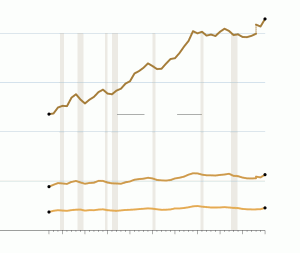America’s Inequality Problem: Real Income Gains Are Brief and Hard to Find
< < Go Back
Working families finally got a raise.
Early on Tuesday, the Census Bureau provided some long-awaited good news for the beleaguered working class: The income of the typical American household perched on the middle rung of the income ladder increased a hearty 5.2 percent in 2015, the first real increase since 2007, the year before the economy sank into recession.
Households all the way down the income scale made more money last year. The average incomes of the poorest fifth of the population increased 6.6 percent after three consecutive years of decline. And the official poverty rate declined to 13.5 percent from 14.8 percent in 2014, the sharpest decline since the late 1960s.
The numbers are heartening, confirming that the sluggish yet consistent recovery of the American economy has finally begun to lift all boats. They fit the story coming from the job market, which is about as tight as it has been in a very long time. They follow rises in the minimum wage across many states and municipalities.
“This shows the importance of robust labor markets,” said Jared Bernstein, a former top economic adviser to Vice President Joseph R. Biden Jr. “If working-age Americans are going to get ahead, it is through a paycheck.”
And yet this positive news — while clearly undermining Donald J. Trump’s unbridled pessimism about the American economy — does not justify unbridled celebration, either.
“The next question is why did it take such a long time for things to look good?” said Arloc Sherman of the Center on Budget and Policy Priorities, a left-leaning policy analysis group. As Sheldon H. Danziger of the Russell Sage Foundation put it, it’s great news that men’s earnings from work increased 1.5 percent. But they are still lower than in the 1970s.
The answer does not just involve sluggish growth. It is also about its distribution. Gains may be finally trickling down to those at the bottom of the ladder. But the numbers still offer a lopsided picture, with a gargantuan share of income rising to the top. While the bottom fifth of households increased their share of the nation’s income, by the census’s definition, to 3.4 percent from 3.3 percent, the richest 5 percent kept 21.8 percent of the pie, the same as in 2014.
More From The New York Times:





